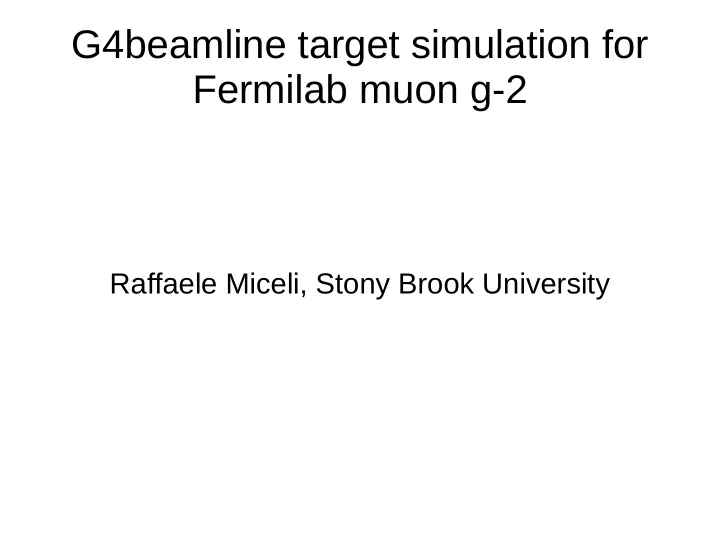

G4beamline target simulation for Fermilab muon g-2 Raffaele Miceli, Stony Brook University
Summary ● The Muon g-2 Experiment, BNL and Fermilab ● Benchmarking G4beamline ● Target Station Simulation ● Future developments
Muon g-2 as a probe for new physics ● Anomalous magnetic moment of a particle is a contribution of quantum mechanics to the magnetic moment of that particle ● Sensitivity to this contribution increases with particle mass ● Muon is used because of its balance between high mass and long lifetime
E821 – BNL g-2 ● Measured g-2 by circulating muons and antimuons in a magnetic storage ring ● Observed precession of muon spin due to magnetic field ● g-2 measured to precision of 540 ppb ● One of the most famous “cracks” in the Standard Model
E989 – Fermilab g-2 ● Will use storage ring from E989 ● Planned fourfold increase in precision of g-2 ● Higher precision from higher quality of pion source + other upgrades ● Ring moved in 2013, data taking to start in 2017
Current state of g-2 simulations ● Target station done in MARS ● Everything else (pion transport, debunching, etc.) done in GEANT4 ● MARS was the best solution for pion production simulations
MARS code system ● Beamline simulation package written in Fortran ● Developed and maintained at Fermilab ● Rather difficult to use unless very experienced
G4beamline (G4BL) ● Front end for GEANT4 with specialized primitives and commands to simplify accelerator design ● No C++ code required to make simulations ● Can directly call Geant4 functions if necessary
My Task(s) ● Compare G4BL to MARS ● Write and test simulation of Fermilab g-2 target station in G4BL
Benchmarking: G4BL vs. MARS ● Wrote a simple simulation of the geometry used in CERN's Hadron Production Experiment (HARP) ● Mentor simulated same geometry in MARS ● Compared pion production results of both simulations with real data from HARP ● Comparison done through double differential cross section, a measure of event probability within a certain momentum-angle bin
Benchmarking Results ● Data sets do not agree very well at low energies (<1.5 GeV/c) ● Agree reasonably well at energies of interest for g-2 (3-4 GeV/c) ● Agreement increases with energies ● G4BL uses physics libraries optimized for HEP, sot this is somewhat expected
Fermilab Pbar Complex ● Source of muons for g-2 and other muon experiments ● Produces pions using proton beam, pions eventually decay to muons
Target Station Simulation ● Models four components: target, lithium lens, collimator and pulsed magnet ● Virtual detectors between components record particle data ● Runs ~1.1 million events/hour on typical desktop machine ● Focuses on particle production; no energy deposition data taken
Visual Overview
Target ● Inconel core (mostly nickel) ● 6 mm beryllium casing ● Takes 8 GeV proton beam and produces secondary particles
Lithium Lens ● Lithium rod with beryllium vacuum windows and titanium casing ● 116 kA current through lithium generates focusing magnetic field
Collimator ● Solid cylinder of copper ● Shields magnet from excess energy deposition ● In simulation, kills particles on contact
Pulsed Magnet ● 0.53 T vertical field bends particle paths ● Particles with momentum around 3.1 GeV/c continue to next part of beamline ● Unbent leftover protons sent to beam dump (not simulated)
Pion Yields ● Target – 0.2 pi+/POT ● Lens – 0.08 pi+/POT ● Collimator – 0.008 pi+/POT ● Dipole – 0.0014 pi+/POT ● About 6 x 10 -6 pi+/POT within 2.5% of magic momentum after dipole
Pion Data - Position
Pion Data - Momentum
Pion Data – Phase Space
Pion Data – Momentum vs. Angle
Bump in collimator data
Fate of lens pions
Results ● Pion production after lens and dipole roughly in line with previous simulations ● Lens and dipole magnet effects (focusing and momentum selection) clearly observable
Future ● Potential for optimization of component parameters using genetic algorithms ● Reconstruction of same target station geometry in MARS for direct comparison ● Streamlining of ROOT analysis scripts ● Implementation on RACF clusters for higher statistics
Recommend
More recommend